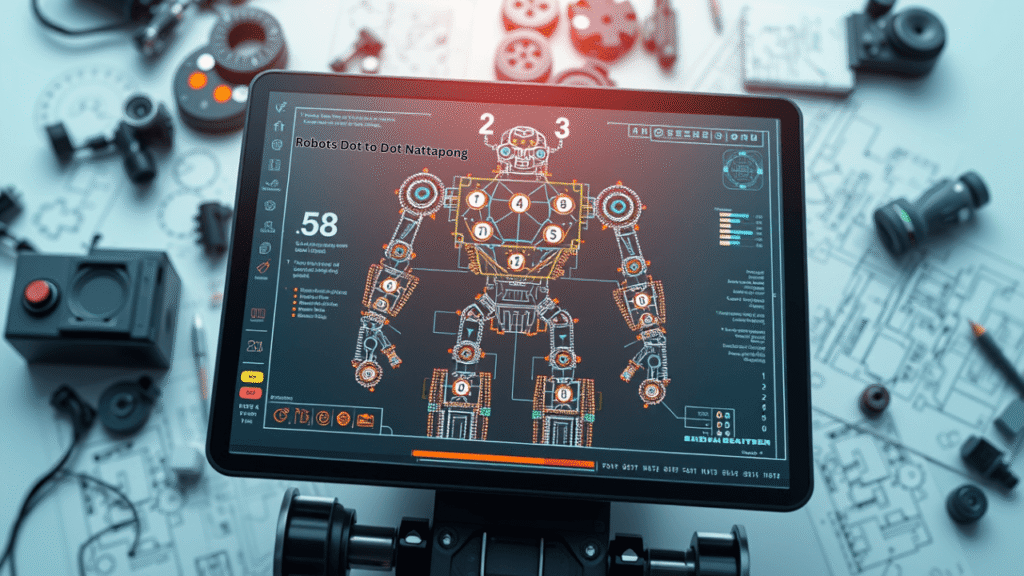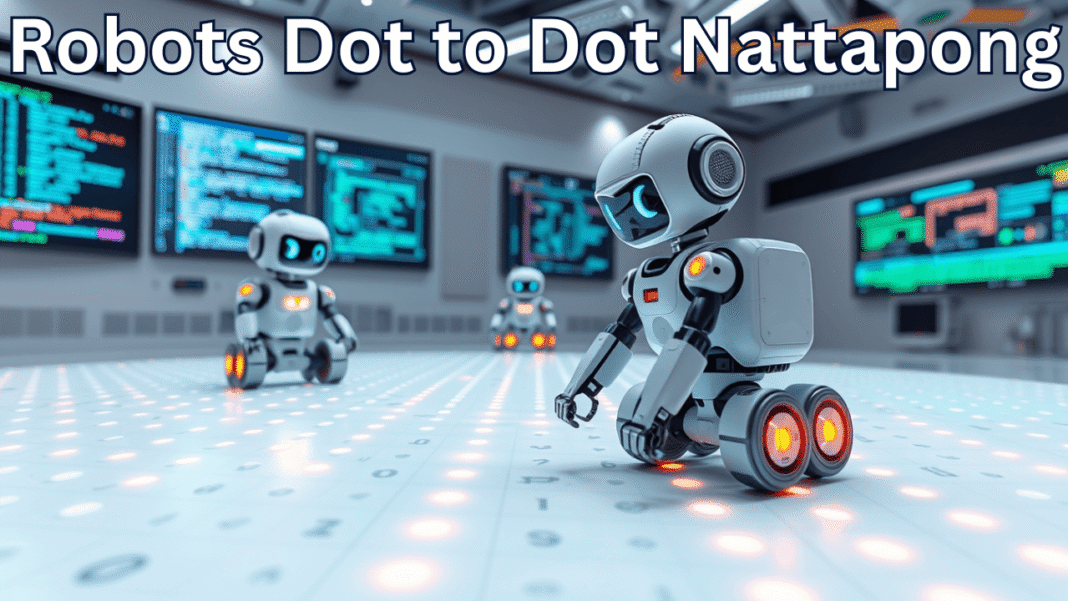Let’s be honest — when we think of robots, most of us picture futuristic machines building cars or roaming Mars. But what if I told you robots are now holding pens and making art? Not just any art — we’re talking about dot-to-dot masterpieces, crafted with machine precision and artistic flair. Yeah, it’s real, and it’s turning heads in both the tech and creative worlds.
One of the most fascinating examples of this robotic creativity is Robots Dot to Dot Nattapong — a cutting-edge blend of artificial intelligence, robotics, and pure artistic expression. Sounds like science fiction? It’s not. Let’s dive into how this tech-driven trend is reshaping the way we look at creativity.
A New Era for Dot-to-Dot Art
You remember those childhood puzzles, right? The ones where you connected dots to reveal a picture of a dog or a spaceship? Those dot-to-dot games were fun, but let’s be honest — they weren’t exactly gallery material.
Well, that’s changing — fast.
From Paper Puzzles to Precision Robots
The dot-to-dot format started off as a playful learning tool. It taught kids focus, order, and pattern recognition. But now, it’s matured. Thanks to AI and robotics, that once-simple concept has transformed into something you’d expect to see hanging in a modern art museum or powering a tech demo at CES.
With advanced software, artists and engineers feed designs into AI systems that calculate thousands of dots. Then, robotic arms execute the patterns with laser accuracy. The result? Complex, beautiful artwork that’s part machine-made, part human-imagined.
So, Who’s Nattapong?
Let’s talk about the name behind the innovation — Nattapong.
No, it’s not the name of the robot itself. It’s the brainchild of a team of brilliant designers and engineers led by Nattapong, a developer whose name now represents a new direction in artistic robotics. Think of it like Steve Jobs with an artistic twist — but instead of iPhones, Nattapong is inspiring a movement where robots become your art buddy.
More Than a Robot — It’s a Creative System
This “Nattapong” system isn’t just some one-size-fits-all machine. It’s modular, flexible, and user-friendly. Artists can tailor the robot’s capabilities based on their unique creative needs — whether they’re designing minimal dot portraits or full-blown, detailed cityscapes.
The Power of Robotics in Dot-to-Dot Art

Here’s where things get juicy. Robots don’t get tired. They don’t shake. They don’t miss a line. That means dot-to-dot art is more refined, scalable, and — let’s face it — cooler than ever before.
1. Precision Like You’ve Never Seen
You could spend hours connecting dots by hand and still end up slightly off. Robots? They hit every point with pinpoint accuracy. It’s like having a digital Leonardo da Vinci — only faster.
2. Speed and Efficiency Redefined
What might take a human artist an entire day, these robotic systems can complete in minutes. And not just simple drawings — we’re talking about intricate portraits, abstract designs, and complex landscapes.
3. Custom Artwork at the Push of a Button
Thanks to AI integration, users can upload an image and instantly turn it into a dot-to-dot layout. Want to make a puzzle out of your dog’s photo? Boom — done. It’s personalized art creation, democratized by machines.
AI: The Invisible Artist Behind the Scenes
Now, let’s lift the curtain and talk about the real wizard here: artificial intelligence.
Smart Design with Machine Learning
AI algorithms analyze images and determine optimal dot placements to keep the composition balanced and visually pleasing. No guesswork, no mess — just smart design from start to finish.
Mimicking the Human Touch
It gets crazier — these AI-powered robots don’t just connect dots. They can mimic different drawing styles, shading techniques, and even imitate human imperfections. So while it’s robotic in precision, the outcome feels wonderfully human.
While exploring how robots are reshaping creativity, it’s also worth looking at how AI is transforming image generation. Tools like Gramhir.pro AI Picture Generator Guide: Features & Perks dive into how machine learning can instantly turn ideas into visuals, offering another glimpse into the future of art and technology.
Beyond the Paper: Dot-to-Dot Meets Other Art Forms
The fun doesn’t stop at static prints. These AI+robot creations are crossing over into other mediums:
- Projection Mapping – Dot-to-dot art is transformed into light shows that can be displayed on buildings or stages.
- 3D Printing – Those dots become coordinates in 3D space, bringing art to life through tangible structures.
- Augmented Reality (AR) – Users can interact with dot puzzles in virtual environments, turning learning into a full-blown experience.
Why Dot-to-Dot Is the Future of Learning & Therapy
This tech isn’t just about pretty pictures. It’s also becoming a powerful tool in education and wellness.
A Gateway to Coding
Believe it or not, dot-to-dot art can introduce kids to basic programming concepts. It’s all about patterns, sequences, and logic — the very skills needed in coding languages like Python or visual platforms like Scratch.
Starting with dot-to-dot and moving into interactive coding games is a natural progression for young minds. It’s fun. It’s visual. It works.
Stress Relief, Reinvented
Dot-to-dot activities are incredibly soothing — a kind of mindfulness in motion. Add the personalization and creative twist brought in by AI, and you’ve got a therapeutic tool that’s as relaxing as it is inspiring.
The Creative Boom: What’s Next for Robots Dot to Dot Nattapong?
As both AI and robotics continue to evolve, this form of art is only going to get more impressive. From classrooms to galleries to living rooms, the applications are nearly endless.
STEM Education Goes Artistic
Robots Dot to Dot Nattapong is being welcomed in STEM education. Why? Because it’s visual, interactive, and way more engaging than a textbook. Students learn the principles of engineering, programming, and digital design all through one fun, accessible platform.
Limitless Possibilities
Artists are already experimenting with more advanced features like color blending, textured effects, and multi-layered dot arrangements. As machine learning improves, the designs will become more intuitive — almost as if the robots are developing their own sense of style.
❓ FAQs Section
Q1: What is Robots Dot to Dot Nattapong?
A: It’s an innovative system combining AI and robotics to create detailed dot-to-dot artwork with machine precision and artistic flair.
Q2: Who created Robots Dot to Dot Nattapong?
A: The concept was developed by a team led by Nattapong, a pioneer in merging robotics and art for new-age creative expression.
Q3: How does AI enhance dot-to-dot art?
A: AI algorithms analyze images, optimize dot placement, and even mimic human drawing styles, adding depth and creativity to robotic art.
Q4: Can anyone use Robots Dot to Dot Nattapong?
A: Yes, it’s designed to be flexible and user-friendly, making it suitable for both professional artists and beginners.
Q5: Where can Robots Dot to Dot Nattapong be applied?
A: Beyond art, it’s used in STEM education, therapy, interactive learning, and even modern exhibitions and installations.
Final Thoughts: A Beautiful Collision of Man and Machine
At its core, Robots Dot to Dot Nattapong is about pushing boundaries. It’s proof that art doesn’t have to be either handmade or high-tech — it can be both. With a little help from AI and robotics, dot-to-dot is no longer child’s play. It’s a playground for innovation.
So whether you’re a teacher looking for the next big ed-tech tool, an artist hungry for new mediums, or just someone who loves seeing machines do cool stuff, this creative movement has something for you.
The robots are drawing — and trust me, the future looks pretty amazing.
Discover how AI is rewriting the rules of creativity in Revolutionizing Storytelling: AI Photo to Video Tools and the Rise of Vidnoz, a must-read for content creators and marketers.



